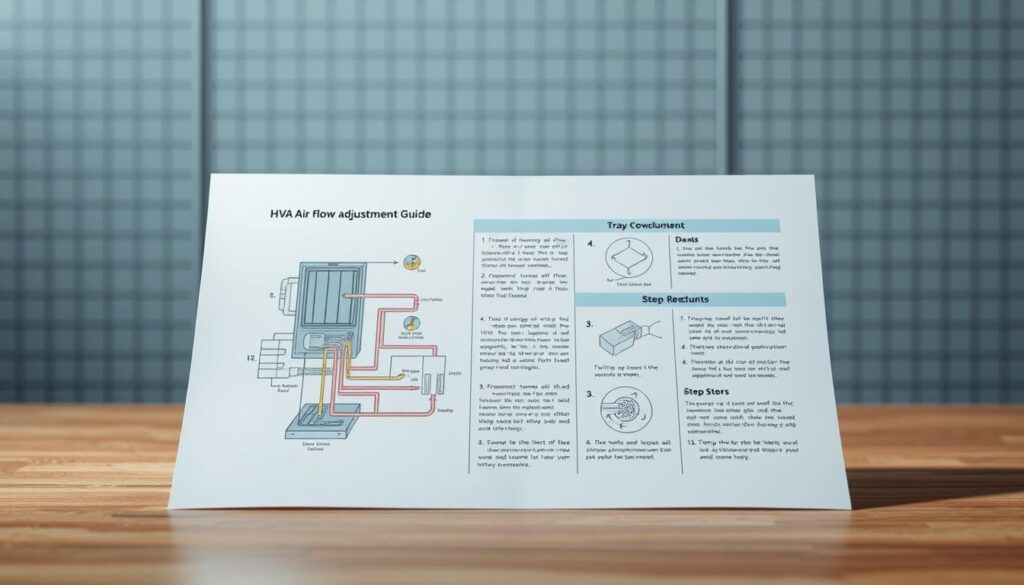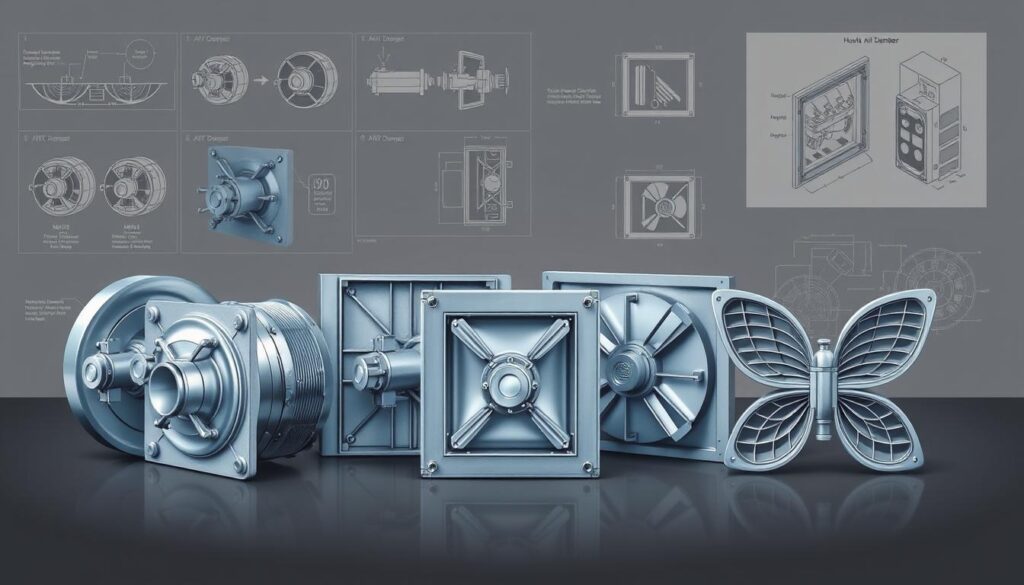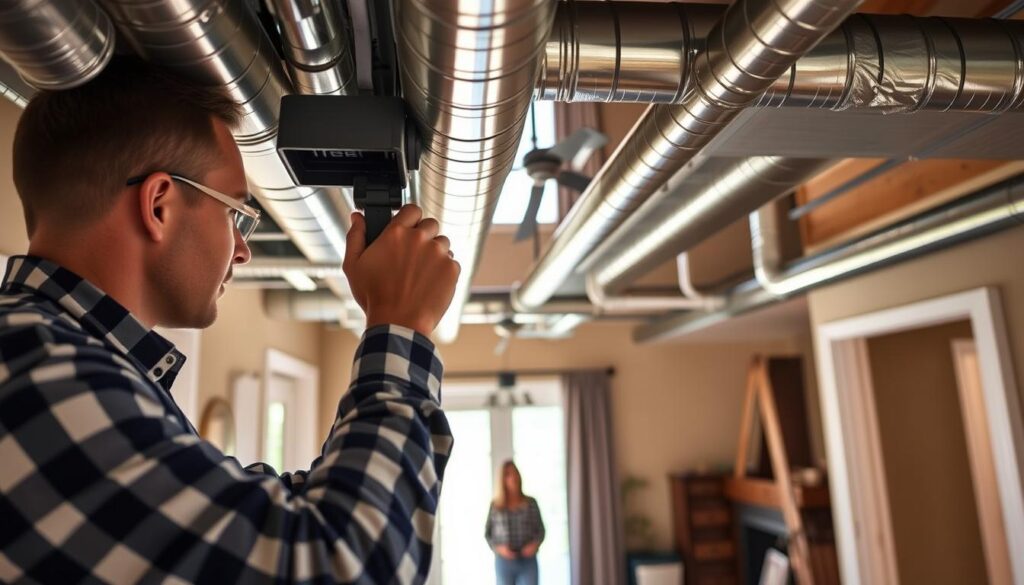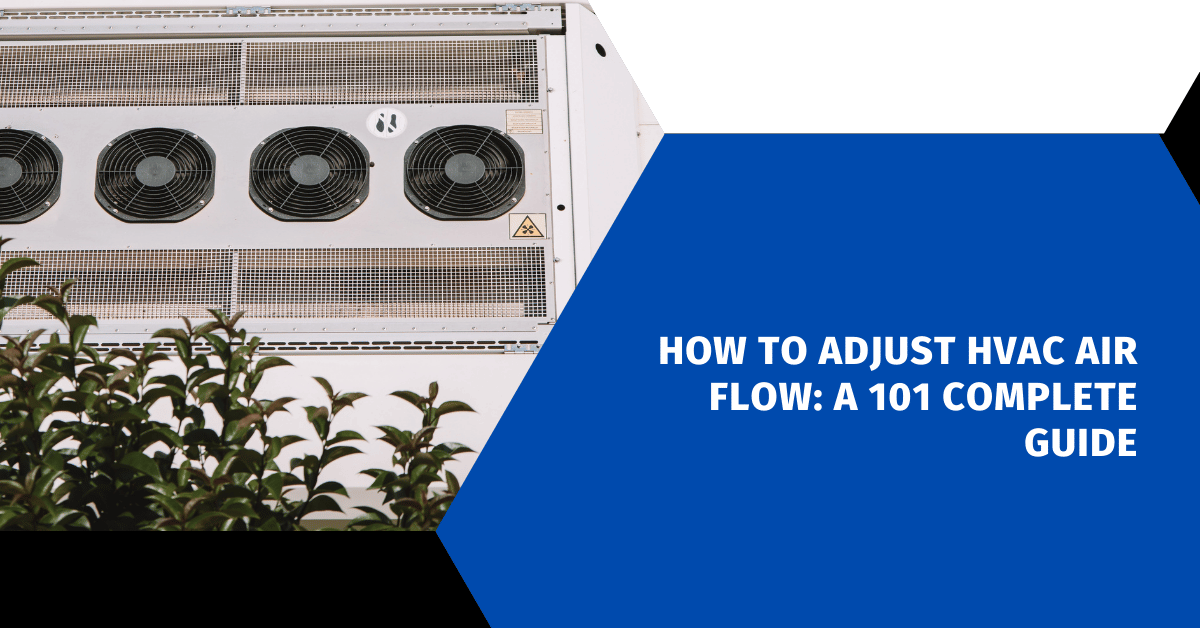Affiliate Disclosure
HVAC Guide Guys is a participant in the Amazon Services LLC Associates Program, an affiliate advertising program designed to provide a means for sites to earn advertising fees by advertising and linking to Amazon.
How to Adjust HVAC Air Flow? Are you tired of uneven temperatures and inconsistent comfort at home? What if you could improve HVAC circulation and make your home perfectly balanced?

Adjusting HVAC air flow is more than a technical task. It’s about creating the perfect comfort zone in your home. By learning how to adjust HVAC air flow, you can make your system work better, save on energy costs, and get rid of those annoying hot and cold spots.
This guide will teach you how to optimize your home’s heating and cooling. Whether you love DIY projects or just want to know more about your HVAC system, you’ll find the key strategies for balanced and efficient air circulation.
Key Takeaways
- Learn critical techniques for improving HVAC circulation
- Understand the importance of proper air flow balance
- Identify signs of improper HVAC system performance
- Discover tools needed for air flow adjustment
- Gain insights into professional and DIY air balancing methods
Table of Contents
Understanding HVAC Air Balancing Basics
Your home’s comfort is more than just the thermostat. Air duct balancing is key to a cozy home. When your HVAC system is balanced, every room is just right – not too hot, not too cold.
Air balancing is about making sure your heating and cooling system spreads air evenly. It’s like adjusting water pressure in showers for a steady flow.
What is Air Balancing?
Air balancing means adjusting your HVAC system’s vents for the best airflow. Experts use special tools to check and tweak:
- Air volume at each vent
- Pressure differences between rooms
- Temperature evenness across areas
- Airflow rates through ducts
Why Air Balance Matters
Getting your air vents right can make your home more comfortable and save energy. An unbalanced system makes your HVAC work too hard, leading to:
- Higher energy bills
- More wear on parts
- Uneven room temperatures
- Lower system performance
Signs of Unbalanced Airflow
Knowing when your HVAC needs balancing is important. Look out for these signs:
- Rooms that feel much warmer or cooler
- Weak airflow from some vents
- Unexpected energy cost hikes
- Sticky hot or cold spots
Understanding air balancing helps you keep your home comfy and efficient.
Essential Tools and Equipment for Air Flow Adjustment
Fixing hvac airflow problems needs the right tools and equipment. Both pros and DIY folks need specific gear to find and fix airflow issues.
Before you start checking airflow, make sure you have these key tools:
- Anemometer: Measures air speed and volume
- Digital thermometer for temperature checks
- Pressure gauge to see how well the system works
- Manometer for air pressure differences
- Flow hood for detailed airflow tests
Don’t forget to have documents ready for troubleshooting:
- Original duct design plans
- Duct layout diagrams
- Details from equipment makers
- System control guides
| Tool | Primary Function | Measurement Accuracy |
|---|---|---|
| Anemometer | Air velocity measurement | ±3% of reading |
| Digital Thermometer | Temperature assessment | ±0.5°F |
| Pressure Gauge | System pressure evaluation | ±1.5% full scale |
Good tools are key for fixing hvac airflow problems. They help find issues fast and fix them for better system performance.
Explore Our HVAC Shop
Looking for top-rated HVAC tools, parts, and accessories? Visit our shop and find the perfect solution for your needs.
Visit the ShopHow to Adjust HVAC Air Flow: Step-by-Step Process
Fixing airflow problems in your home needs a step-by-step plan. Learning how to adjust your HVAC system can make your home more comfortable and save energy.
First, you must assess your system fully. This step helps find any issues that might affect your home’s air flow.
Initial System Assessment
Begin by checking your HVAC system visually. Look for signs like:
- Blocked or closed air vents
- Visible ductwork damage
- Dust around registers
- Uneven temperatures in your home
Measuring Current Airflow
Measuring air flow accurately is key. Use a digital airflow meter to check each vent’s air volume. Record these readings to guide your adjustments.
Making Necessary Adjustments
To fix airflow issues, follow these steps:
- Find the biggest airflow problems
- Adjust ductwork dampers a little at a time
- Check air flow after each adjustment
- See how the whole system is doing
Pro tip: Small, gradual changes are more effective than big ones.
Precision is key when balancing your home’s HVAC system. Take your time and be methodical in your approach.
Types of HVAC Dampers and Their Functions

Knowing how to adjust dampers is key to solving uneven cooling issues in your home. Dampers help control airflow and keep temperatures even across your space.
There are various dampers, each with its own role in your heating and cooling system:
- Butterfly Dampers: Circular flat design perfect for round ductwork
- Blade Dampers: Adjustable metal blades that precisely control air volume
- Inlet Vane Dampers: Ideal for regulating air intake in larger systems
- Louver Dampers: Versatile option for complex ventilation needs
When picking dampers, think about what your HVAC system needs. Each type has its own strengths in managing airflow and temperature.
“Proper damper selection can dramatically improve your home’s comfort and energy efficiency.” – HVAC Engineering Experts
Learning about these damper adjustment techniques can help you improve your home’s air flow. It can get rid of hot and cold spots, making your home more comfortable.
Explore Our HVAC Shop
Looking for top-rated HVAC tools, parts, and accessories? Visit our shop and find the perfect solution for your needs.
Visit the ShopLocating and Operating HVAC Dampers
Knowing how to adjust HVAC air flow is key for comfort at home. Dampers help by controlling air flow in your heating and cooling system.
HVAC dampers are precise tools for managing air in your ducts. They let you adjust temperatures and comfort in various home areas with great accuracy.
Common Damper Locations in Your Home
- Main trunk lines near major duct junctions
- Vertical duct branches
- Basement and attic ductwork
- Central air handling unit
Proper Damper Operation Techniques
To adjust hvac air flow well, follow these steps:
- Find the damper handle or lever
- See if it’s open or closed
- Adjust it slowly to the airflow you want
- Check room temperatures after changing
Seasonal Adjustment Guidelines
| Season | Damper Adjustment Strategy | Goal |
|---|---|---|
| Summer | Open upper floor dampers | Improve cooling circulation |
| Winter | Close upper floor dampers | Direct heat to lower levels |
| Spring/Fall | Balanced damper positioning | Even temperature distribution |
Pro tip: Always make gradual adjustments and monitor your home’s comfort levels to find the perfect balance.
Balancing Multi-Level Homes

Fixing uneven cooling in multi-level homes needs a smart plan for duct balancing. Your home’s temperature can change a lot between floors. This makes living spaces uncomfortable, even with the best HVAC systems.
It’s common for temperature to differ between floors in multi-level homes. Warm air goes up, so upper floors are warmer in summer and cooler in winter. Knowing this helps you use the right duct balancing methods.
- Upper floors need more cooling in summer
- Lower floors need more heating in winter
- Damper adjustments help control airflow
Managing dampers is key for even temperatures. Seasonal changes are important for home comfort. In summer, open dampers on upper floors for cool air. In winter, send warm air to lower floors and block it from going up.
Experts say to check your HVAC system often to fix cooling issues. Knowing where to place dampers and your home’s airflow helps keep temperatures even.
Proper residential duct balancing makes multi-level home comfort great.
Common Airflow Problems and Solutions
Dealing with HVAC airflow issues can be tough for homeowners. Knowing the usual problems helps you fix them fast. This keeps your home comfy and saves energy.
Fixing airflow problems needs a step-by-step plan. Homeowners face many common issues. These can affect how well your heating and cooling work.
Hot and Cold Spots
Uneven temperatures are a big HVAC problem. These hot and cold spots usually come from:
- Blocked air vents
- Poorly designed ductwork
- Inadequate insulation
- Obstructed return air registers
Pressure Imbalances
Pressure issues can make your home feel uncomfortable. Signs include:
- Doors that slam shut unexpectedly
- Whistling sounds from vents
- Difficulty opening or closing interior doors
- Rooms feeling stuffy or drafty
System Noise Issues
Strange sounds from your HVAC system often mean airflow problems. Potential noise sources include:
- Loose ductwork connections
- Dirty air filters
- Misaligned fan blades
- Worn-out mechanical components
Experts say regular maintenance stops these airflow issues. Fixing problems early keeps your system running well. This keeps your home comfortable.
Explore Our HVAC Shop
Looking for top-rated HVAC tools, parts, and accessories? Visit our shop and find the perfect solution for your needs.
Visit the ShopProfessional vs DIY Air Balancing
Choosing between professional and DIY air duct balancing can be tough. Some adjustments are easy, but others need expert skills to work right.
Professional HVAC techs have the skills and precision for air duct balancing. They do:
- Comprehensive system diagnostics
- Detailed airflow measurements at each vent
- Advanced testing equipment
- Precise calibration techniques
DIY balancing might work for simple tweaks, but complex systems need pros. Experts use tools like:
- Digital anemometers
- Static pressure gauges
- Duct traverse measurement devices
When should you call a professional? Get expert help if you see:
- Persistent hot or cold spots
- Uneven temperature distribution
- High energy bills
- Unusual system noises
Professional air duct balancing costs $300-$500 but saves money on energy. Trained techs find issues that DIYers miss, keeping your HVAC running well.
Investing in professional air balancing is often more cost-effective than repeated DIY attempts.
While some homeowners are okay with small tweaks, complex air flow issues need pros. HVAC techs know how to boost airflow and keep systems efficient.
Conclusion
Learning to adjust HVAC air flow is key for home comfort and saving energy. It helps you understand air balancing, making your home more comfortable and saving money. This process needs patience, precision, and a step-by-step approach to better HVAC circulation.
Air balancing is an ongoing task. Your HVAC system needs regular checks as seasons change and your home’s needs grow. Start by measuring airflow, making small damper adjustments, and checking your work. Aim for balanced air that keeps all rooms at a comfortable temperature.
Some homeowners try to adjust air flow on their own. But, if you face ongoing issues, get help from a professional HVAC technician. They can help with complex systems or problems that affect your home’s comfort and energy use.
With the knowledge from this guide, you can improve your HVAC system’s performance. Understand your system, use the right tools, and be patient and detailed. Your hard work will make your home more comfortable and could lower your energy bills.

